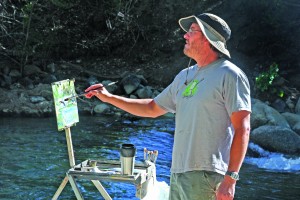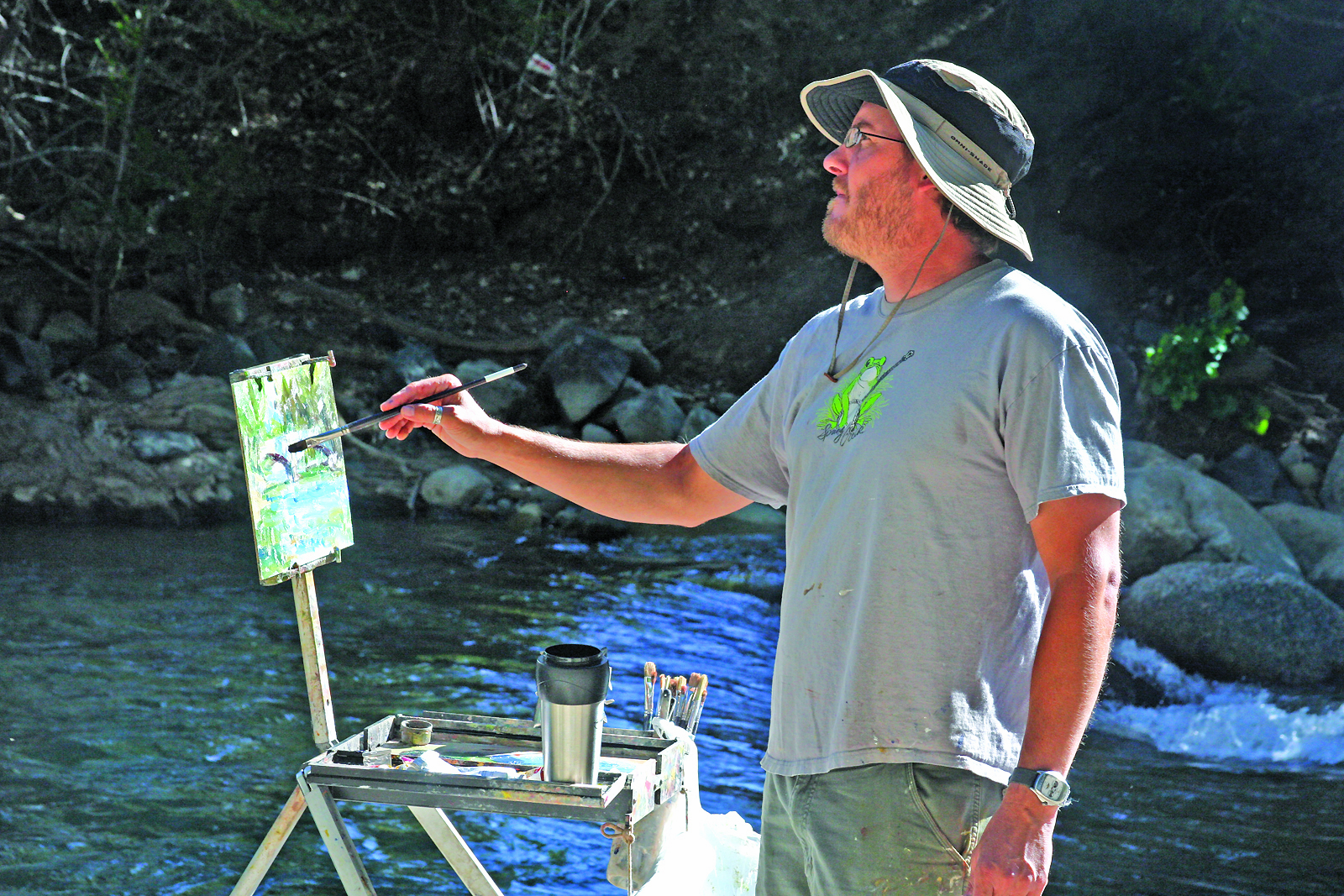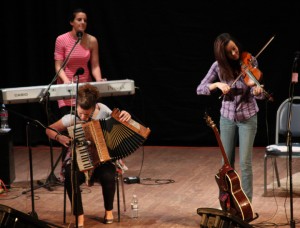By Mike Rosso
“I am following Nature without being able to grasp her, I perhaps owe having become a painter to flowers.” – Claude Monet
They ply their craft, insects circling their heads. A sudden gust of wind upends several hours of work. Random clouds blot out the sun shortly before the dreaded rains begin to fall. Passersby freely offer unsolicited opinions.
These are only some of the hazards a landscape painter might encounter when they decide to abandon their studios for the great outdoors. Yet the desire to paint from real life, in the moment, is attracting more and more artists – drawn to the challenges and to the pure joy of en plein air, a French term for “in the open air.”

Until the advent of paint tubes, most artists worked in studios, creating their own paints from oils and powdered color pigments. Working outdoors was cumbersome and clumsy, yet early painters strove to duplicate the beauty found only in natural light. It was in the late 1800s that artists broke free of the bonds of their studios and began venturing outdoors, employing a new device called the French Box Easel – a tripod, easel, palette and paint box all in one – allowing them to venture farther afield with minimal encumbrance. With the advent of lead paint tubes French Impressionists began using the outdoors to capture not details, but visual effects. They painted color and the relationships of shadows and light in short, broken strokes rather than smooth blends of paint traditionally employed until that time.
Among the more noted of these were Paul Cézanne, Pierre-August Renoir, Mary Cassatt and Claude Monet. It is said the rise in the Impressionist movement was partially sparked by the advent of photography which allowed for instantaneous capture of a live scene. Painters followed suit in order to render their subjects subjectively.
Although the technique of outdoor painting never quite fell out of fashion, it was eclipsed in the twentieth century by other art movements such as Cubism and Abstractionism. It has seen quite a revival of late with artists hungering to get back to basics. The current movement in Colorado and in the West has a large following, reflected in the number of plein air festivals which have sprouted up in the past decade. From Sedona and the Grand Canyon in Arizona, to Telluride and Crested Butte, Colorado, artists from across the country arrive to breathe in fresh mountain air and render majestic scenery on canvas with their peers.
There are several plein air festivals here in Central Colorado, including a Plein Air Paint Out and Exhibit Sale in coming up in Westcliffe September 19 and the Rocky Mountain Plein Air Painters National Event held this past July in Crested Butte. A MountainAire Painters Exhibit was recently featured at the Gunnison Arts Center and an event coming this year from September 16 – 26 in Buena Vista and Salida, the Colorado Mountain Plein Air Festival (CMPAF) hopes to draw artists from around the country.
Started in 2008, the festival is the brainchild of Upper Ark Valley artists including Fred Hubicki, Joshua Been, Danna Tullis, Gloria Jean Countryman and Tammy LaVercombe, who began it as a “shoulder-season” event to lure artists and other visitors to the valley before the ski season. That first year brought 55 painters from the region to participate in “paint-outs,” in which painters enjoy outings to places such as the ghost town of Garfield to render their impressions of that area, later to be hung and judged by other artists.
Among the other festival events are a “quick draw” as painters are given a specific time period to complete their works which are also judged, and a paint-out at the B.V. Farmer’s Market.
One of the organizers of the 2010 event is Nora Larimar, owner of the Rock Run Gallery in Buena Vista and winner of the “Best of Show” award at the first CMPAF. She described plein air painting as “an honest response to what you are seeing in the moment … working with shifting light and weather conditions.”
Other organizers for this year’s event include Dee Fabian, Gigi Griefenberg, Tammy LaVercombe and Robin Ziperman.
Salida artist Joshua Been considers it “getting back to the core.” The winner of numerous plein air events, Been says he creates 80 to 90 percent of his work outdoors, rarely working from photographs. “The moment you take a picture you’re separated from the truth,” he says.
Since its inception he has offered workshops at the festival including an oil painting workshop this year. A pastel workshop will also be offered by the artist featured on our September cover, Susan Mayfield.
Been says there are three levels of plein air festivals: entry-level such as the CMPAF, juried festivals in which artists are selected based on submitted examples of their work, and invitationals for the top of the crop artists. This year’s festival will be judged by Kimberly Moore, Fine Arts Sales Manager for Southwest Art Magazine who will be selecting the “business award,” and renowned Pueblo artist Teresa Vito, a plein air painter for over 20 years who believes one of the reasons the movement has caught on recently is because “the baby boomers are maturing and have more time to experiment with things they have always wanted to do.”
She went on, “Nothing gives you such knowledge and awareness as painting from life. Have you noticed that when you return from a vacation and look at your photos, often times you ask yourself ‘Why did I take that picture’? A camera does not capture what and how we see, and does not edit and emote what we can capture on canvas. It also opens up your world when you realize that everything around you could possibly be a painting. There is no need to go to an exotic location or have the perfect studio. This movement has created an influx of travel easels and materials to make the experience a lot more manageable. You only have about two hours to paint because the light changes so fast, therefore you are painting by the seat of your pants and often create a spontaneous expression that is not noodled to death and has an energy that you usually don’t achieve in a studio painting”.
Asked about her standard for judging a show, Vito said she tries to keep to a basic criteria, not letting her personal likes of medium, subject matter or expression influence her decision. She looks for excellence in design and composition, a good use of color and temperature, knowledge of tonal values, drawing ability, a variety of edges and a mastery of handling the medium. She also considers emotional impact. She judges the final artwork on all these plus she considers the presentation, i.e., the frame and base, etc.
Patricia Amlin, who divides her time between Gunnison and Santa Fe, NM, is a highly respected painter who began plein air painting when she was a Fulbright student in Europe in 1958. As she describes it, “I wandered from beautiful town to historical monument sitting on curbs with my paints on my lap. People would arrive and offer me coffee, tables, invitations to local weddings in Greece, cultural presentations, sailboat rides … anything that one can imagine. It was a perfect way to interact with a foreign place using the universal language of painting. This year was one of my most exciting. I discovered the Colorado high mountains; Paradise Divide, Emerald Lake, Cottonwood Pass. I set up a camp, slept through the high winds and storms of the monsoon season and adapted my schedule to Creation’s. I felt so enveloped by our amazing natural world that I once parked my camp stool in a stream so as to not disturb the wildflowers. A deer, reminiscent of a Japanese Animee Guardian Forest Spirit, followed every stroke of my brush that afternoon. Plein Air painting is a profoundly special way to live and be in union with our natural world.”
For more information please visit:
www.coloradomountainpleinairfestival.com
ww.teresavito.com
www.rmpap.org
www.patriciaamlin.com
www.joshuabeen.com
www.rockrungallery.com


